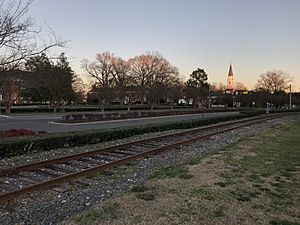Misenheimer, North Carolina facts for kids
Misenheimer is a small village in Stanly County, North Carolina, in the United States. It's located in the southern Piedmont area of North Carolina, close to the town of Richfield. In 2010, about 728 people lived there.
Misenheimer is known as a college town because it's home to the main campus of Pfeiffer University. This university grew from a high school into a college thanks to money from Henry and Annie Merner Pfeiffer. Another important school, Gray Stone Day School, a special charter high school, used to be on Pfeiffer's land. In 2011, Gray Stone moved to its own new campus in Misenheimer.
U.S. Route 52 goes right through Misenheimer, connecting Salisbury to Albemarle. This highway, along with a Norfolk Southern Railroad track, actually cuts through the Pfeiffer University campus. Misenheimer might have been the only town in America where its only traffic light wasn't at a street intersection. Instead, it was at a crosswalk to help students and others safely cross U.S. 52 between the two parts of Pfeiffer's campus.
Contents
History of Misenheimer
Gold Discovery and Rush
In 1825, a man named Matthias Tobias Barringer found gold nuggets on his farm. He found a lot of gold, and later, the country's first gold vein in quartz rock. News of his discovery spread across the country, starting North Carolina's gold rush.
Later, new owners worked the mine. In 1903, the Whitney Company bought the mine. They found a huge amount of gold, which helped pay for a big project on the Yadkin River. However, on August 11, 1904, a terrible flood happened at the mine. Eight men died, and the mine eventually closed down. It didn't open again until 1998.
Railroad and Town Growth
In the late 1800s, Misenheimer was a train stop called Gladstone. It was on a railroad line that went to Misenheimer Springs, a popular place for tourists back then.
Misenheimer officially became a village on June 26, 2003. This happened because a bill was passed by the North Carolina General Assembly. A big reason for this was that U.S. 52 and N.C. 49 were going to be made wider. People expected this would bring more growth to the area. One of the first things the new village leaders did was to stop heavy industries, like reopening the old Barringer gold mine.
Population of Misenheimer
| Historical population | |||
|---|---|---|---|
| Census | Pop. | %± | |
| 2010 | 728 | — | |
| 2020 | 650 | −10.7% | |
| U.S. Decennial Census | |||
As of the 2020 United States census, there were 650 people living in the village.
See also
 In Spanish: Misenheimer para niños
In Spanish: Misenheimer para niños


